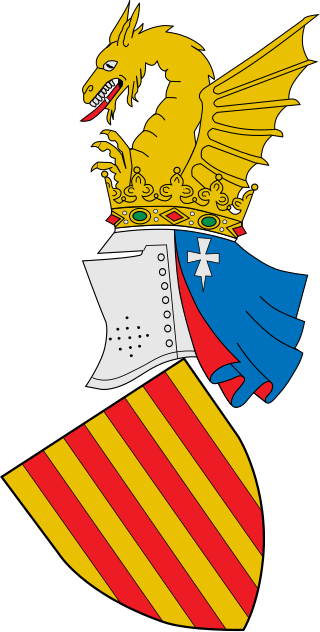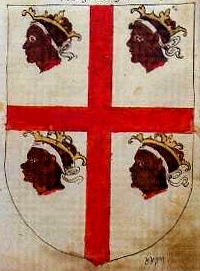This article may be expanded with text translated from the corresponding article in German. (October 2018)Click [show] for important translation instructions.
|

A Moor's head, since the 11th century, is a symbol depicting the head of a black moor.
This article may be expanded with text translated from the corresponding article in German. (October 2018)Click [show] for important translation instructions.
|

A Moor's head, since the 11th century, is a symbol depicting the head of a black moor.
The precise origin of the Moor's head is a subject of controversy. But the most likely explanation is that it is derived from the heraldic war flag of the Reconquista depicting the Cross of Alcoraz, symbolizing Peter I of Aragon and Pamplona's victory over the "Moorish" kings of the Taifa of Zaragoza in the Battle of Alcoraz in 1096. The blindfold may originally have been a headband. [1]
Another theory claims that it is the Nubian Saint Maurice (3rd century AD). [2]
The earliest heraldic use of the Moor's head is first recorded in 1281, during the reign of Peter III of Aragon and represents the Cross of Alcoraz, which the King adopted as his personal coat of arms. [3] The Crown of Aragon had for a long time governed Sardinia and Corsica, having been granted the islands by the Pope, although they never really exercised formal control. The Moor's head became a symbol of the islands. [4]
This symbol is used in heraldry, vexillography, and political imagery.
The main charge in the coat of arms in Corsica is a U Moru, Corsican for "The Moor". An early version is attested in the 14th-century Gelre Armorial, where an unblindfolded Moor's head represents Corsica as a state of the Crown of Aragon. Interestingly, the Moor's head is attached to his shoulders and upper body, and he is alive and smiling. In 1736, it was used by both sides during the struggle for independence.
In 1760, General Pasquale Paoli ordered the necklace to be removed from the head and the blindfold raised. His reason, reported by his biographers, was "Les Corses veulent y voir clair. La liberté doit marcher au flambeau de la philosophie. Ne dirait-on pas que nous craignons la lumière ?" (English: "The Corsicans want to see clearly. Freedom must walk by the torch of philosophy. Won't they say that we fear the light?") The blindfold was thereafter changed to a headband.
The current flag of Corsica is the Bandera testa Mora, 'Flag with head of Moor', is male rather than female, and has a regular knot at the back of the head.
The flag of Sardinia is informally known as the Four Moors (Italian : I quattro mori, Logudorese : Sos Bator Moros, Campidanese : Is Cuatru Morus) and comprises four Moor heads.
The "Maure" is the African Unification Front's flag and emblem. The head is blindfolded representing the impartiality of justice, and the knot is tied into a stylized Adinkra symbol for omnipotence (Gye Nyame). [5]

Modern anti-racism efforts, coupled with increased African immigration to Europe and a growth of the Afro-European population, have led to controversies around ancient "Moor's head" symbols. [6] For example, the Austrian company Mohrenbrauerei was asked to remove the "Moor's head" from its bottles. [7]

The term Moor, derived from the ancient Mauri, is an exonym first used by Christian Europeans to designate the Muslim inhabitants of the Maghreb, the Iberian Peninsula, Sicily and Malta during the Middle Ages.

In heraldry, Saint George's Cross, the Cross of Saint George, is a red cross on a white background, which from the Late Middle Ages became associated with Saint George, the military saint, often depicted as a crusader.

Filippo Antonio Pasquale de' Paoli was a Corsican patriot, statesman, and military leader who was at the forefront of resistance movements against the Genoese and later French rule over the island. He became the President of the Executive Council of the General Diet of the People of Corsica and wrote the Constitution of the state.

The personal papal coat of arms of Pope Benedict XVI was designed by Archbishop Andrea Cordero Lanza di Montezemolo soon after the papal election in 2005.

The emblem of the Italian Republic was formally adopted by the newly formed Italian Republic on 5 May 1948. Although often referred to as a coat of arms, it is an emblem as it was designed not to conform to traditional heraldic rules. The emblem is used extensively by the Italian government.

Blackamoor is a type of figure in European decorative art, from the Early Modern period, depicting a black man. Common examples of items and objects decorated in the blackamoor style include sculpture, jewellery, and furniture. Typically the sculpted figures carried something, such as candles or a tray. They were thus an exotic and lightweight variant for the "atlas" in architecture and decorative arts, especially popular in the Rococo period.

The flag of Sardinia, called the flag of the Four Moors or simply the Four Moors, represents and symbolizes the island of Sardinia (Italy) and its people. It was also the historical flag and coat of arms of the Aragonese, then Spanish, and later Savoyard Kingdom of Sardinia. It was first officially adopted by the autonomous region in 1950 with a revision in 1999, describing it as a "white field with a red cross and a bandaged Moor's head facing away from the hoist in each quarter".

The history of Corsica goes back to antiquity, and was known to Herodotus, who described Phoenician habitation in the 6th century BCE. Etruscans and Carthaginians expelled the Phoenicians, and remained until the Romans arrived during the Punic Wars in 237 BCE. Vandals occupied it in 430 CE, followed by the Byzantine Empire a century later.

The flag of Corsica was adopted by General of the Nation Pasquale Paoli in 1755 and was based on a traditional flag used previously. It portrays a Moor's head in black wearing a white bandana above his eyes on a white background. Previously, the bandana covered his eyes; Paoli wanted the bandana moved to above the eyes to symbolise the liberation of the Corsican people from the Genoese.

The coat of arms of Aragon was first chronicled in 1499 by Pablo Hurus. The coat displays Aragon through the years from its establishment to their monarchy and is made up of four shields:

The Coat of arms of Balearic Islands is described in the Spanish Law 7 of November 21, 1984, the Law of the coat of arms of the Autonomous Community of Balearic Islands. Previously, by Decree of the Interinsular General Council of August 7 and 16, 1978, adopted the coat of arms as official symbol of the Balearic Islands.

The coat of arms of the Valencian Community is the official emblem of the self-government institutions of the Valencian Community. It is based on the armorial achievement used from the reign of King Peter IV to John II, called the Great. In 1978 the former Council of the Valencian Country approved it “...for being the oldest known representative emblem of the former Kingdom of Valencia, that had located on the Xerea Gate of the city of Valencia”.

The Kingdom of Sardinia, also referred to as the Kingdom ofSavoy-Sardinia, Piedmont-Sardinia, or Savoy-Piedmont-Sardinia during the Savoyard period, was a state in Southern Europe from the early 14th until the mid-19th century.

The Battle of Alcoraz took place between 1094 and 1096 outside Huesca, pitting the besieging forces of Peter I of Aragon and Navarre against the allied forces of Al-Musta'in II of the Taifa of Zaragoza and García Ordóñez de Nájera and Gonzalo Núñez de Lara representing Alfonso VI of León and Castille.

The heads of humans and other animals are frequently occurring charges in heraldry. The blazon, or heraldic description, usually states whether an animal's head is couped, erased, or cabossed. Human heads are often described in much greater detail, though some of these are identified by name with little or no further description.
A national coat of arms is a symbol which denotes an independent state in the form of a heraldic achievement. While a national flag is usually used by the population at large and is flown outside and on ships, a national coat of arms is normally considered a symbol of the government or the head of state personally and tends to be used in print, on armorial ware, and as a wall decoration in official buildings. The royal arms of a monarchy, which may be identical to the national arms, are sometimes described as arms of dominion or arms of sovereignty.

Albanian heraldry is the use of heraldic symbols in Albania. The earliest form of Albanian heraldry is from the late 12th century, with the creation of the first Albanian medieval country, the Principality of Arbanon in 1190. During the 13th to the 15th century, a great number of medieval Albanian noble families had at their coat of arms the symbol of eagle like the Kastrioti, Muzaka, Arianiti, Dukagjini, but the most prominent being the Kastrioti's coat of arms, having a black double headed eagle, which became a national symbol of the Albanians during Skanderbeg's reign in the 15th century, as well as the official national flag of Albania from 1912.

The French expedition to Sardinia was a short military campaign fought in 1793 in the Mediterranean Sea in the first year of the War of the First Coalition, during the French Revolutionary Wars. The operation was the first offensive by the new French Republic in the Mediterranean during the conflict, and was directed at the island of Sardinia, part of the Kingdom of Sardinia. Sardinia was neutral at the time, but immediately joined the anti-French coalition. The operation was a failure, with attacks directed at Cagliari in the south and La Maddalena in the north both ending in defeat.

The coat of arms of Castile was the heraldic emblem of its monarchs. Historian Michel Pastoureau says that the original purpose of heraldic emblems and seals was to facilitate the exercise of power and the identification of the ruler, due to what they offered for achieving these aims. These symbols were associated with the kingdom, and eventually also represented the intangible nature of the national sentiment or sense of belonging to a territory.

The Cross of Alcoraz is the name given to a heraldic coat of arms and flag made up of the Cross of Saint George, or cross of gules on Argent, with a Maure, or Moor's head, in each quarter. The earliest documented evidence of these arms is in a rare lead-sealed decree from the chancery of Peter III of Aragon, circa 1281, most likely used as the King's personal coat of arms, alluding to the spirit of the Crusades and his ancestral namesake, Peter I of Aragon. The arms also appear in the third quarter of the current Coat of arms of Aragon.